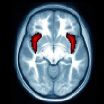The international standard for time is set by atomic clocks -- room-sized apparatuses that keep time by measuring the natural vibration of atoms in a vacuum. The frequency of atomic vibrations determines the length of one second -- information that is beamed up to GPS satellites, which stream the data to ground receivers all over the world, synchronizing cellular and cable networks, power grids, and other distributed systems.
Now a group at MIT and Draper Laboratory has come up with a new approach to atomic timekeeping that may enable more stable and accurate portable atomic clocks, potentially the size of a Rubik's cube. The group has outlined its approach in the journal Physical Review A.
While chip-sized atomic clocks (CSACs) are commercially available, the researchers say these low-power devices -- about the size of a matchbox -- drift over time, and are less accurate than fountain clocks, the much larger atomic clocks that set the world's standard. However, while fountain clocks are the most precise timekeepers, they can't be made portable without losing stability.
"You could put one in a pickup truck or a trailer and drive it around with you, but I'm guessing it won't deal very well with the bumps on the road," says co-author Krish Kotru, a graduate student in MIT's Department of Aeronautics and Astronautics, and a Draper Lab Fellow. "We have a path toward making a compact, robust clock that's better than CSACs by a couple of orders of magnitude, and more stable over longer periods of time."
Kotru says such portable, stable atomic clocks could be useful in environments where GPS signals can get lost, such as underwater or indoors, as well as in militarily "hostile environments," where signal jamming can block traditional navigation systems.
Co-authors of the paper include Justin Brown, David Butts, Joseph Kinast, and Richard Stoner of Draper Laboratory.
A shift in Time
The team came up with the new atomic timekeeping approach by making several "tweaks" to the standard method.
The most accurate atomic clocks today use cesium atoms as a reference. Like all atoms, the cesium atom has a signature frequency, or resonance, at which it oscillates. Since the 1960s, one second has been defined as 9,192,631,770 oscillations of a cesium atom between two energy levels. To measure this frequency, fountain clocks toss small clouds of slow-moving cesium atoms a few feet high, much like a pulsed fountain, and measure their oscillations as they pass up, and then down, through a microwave beam.
Instead of a microwave beam, the group chose to probe the atom's oscillations using laser beams, which are easier to control spatially and require less space -- a quality that help in shrinking atomic clock apparatuses. While some atomic clocks also employ laser beams, they often suffer from an effect called "AC Stark shift," in which exposure to an electric field, such as that produced by a laser, can shift an atom's resonant frequency. This shift can throw off the accuracy of atomic clocks.
"That's really bad, because we're trusting the atomic reference," Kotru says. "If that's somehow perturbed, I don't know if my low-quality wristwatch is wrong, or if the atoms are actually wrong."
To avoid this problem, most standard fountain clocks use microwave beams instead of lasers. However, Kotru and his team looked for ways to use laser beams while avoiding AC Stark shift.
Keeping Time, in Miniature
In laser-based atomic clocks, the laser beam is delivered at a fixed frequency and intensity. Kotru's team instead tried a more varied approach, called Raman adiabatic rapid passage, applying laser pulses of changing intensity and frequency -- a technique that is also used in nuclear magnetic resonance spectroscopy to probe features in individual molecules.
"For our approach, we turn on the laser pulse and modulate its intensity, gradually turning it on and then off, and we take the frequency of the laser and sweep it over a narrow range," Kotru explains. "Just by doing those two things, you become a lot less sensitive to these systematic effects like the Stark shift."
In fact, the group found that the new timekeeping system suppressed the AC Stark shift by a factor of 100, compared with a conventional laser-based system. Unlike fountain clocks, which shoot atoms more than a meter upwards in order to measure a single second, the team's apparatus measures time in intervals of 10 milliseconds -- an approach that is less accurate than fountain clocks, but much more compact.
"That's fine, because we're not trying to make the world's standard -- we're trying to make something that would fit in, say, a Rubik's cube, and be stable over a day or a week," Kotru says.
The stability and accuracy of the system, he says, should be comparable to that of microwave-based atomic clocks on today's GPS satellites, which are bulky and expensive.
Going a step further, the team tested the system's response to physical forces. "Let's say one day we got it small enough so you could put it in your backpack, or in your vehicle," Kotru says. "Having it be able to operate while you're moving across the ground is important."
Just short of physically shaking the system, the group "created a displacement between the atoms and the laser beam," moving the laser beam from side to side as it probed the cloud of atoms. Even under such simulated shaking, the system was able to measure the atoms' resonant frequency, with a high degree of sensitivity.
The team is now working to reduce the size of other components of the system, including the vacuum chamber and electronics.
"Additional miniaturization could ultimately result in a handheld device with stability orders of magnitude better than compact atomic clocks available today," Kotru says. "Such a device would satisfy requirements for more technologically intensive applications, like the synchronization of telecommunications networks."
INFORMATION:
This research was sponsored by Draper Laboratory.
Written by Jennifer Chu, MIT News Office
